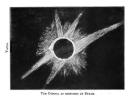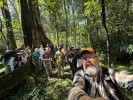The Conversation
Archeoastronomy uses previous total solar eclipses to help us measure history
March 12, 2024
Share

A photograph of the 2017 total solar eclipse, taken at the Oregon State Fair Grounds, Salem, Ore. (Dominic Hart/NASA)
In 648 BCE, the Greek poet Archilochus wrote that, “nothing can be surprising any more or impossible or miraculous, now that Zeus, father of the Olympians has made night out of noonday, hiding the light of the gleaming Sun.”
Total solar eclipses have fascinated and terrified people for centuries. Today, we know that total solar eclipses — like the upcoming eclipse on April 8 — are caused by a cosmic coincidence when the moon comes between the Earth and the sun, momentarily blocking the sun from view. But in ancient times, the cause was unknown.
Nevertheless, the peoples of those eras took note. From all ends of the Earth, stories abound of day turning to night or the sun being consumed, and these records are opening up a new branch of study.
Astroarcheology — also called archeoastronomy — uses astronomical records to help date key moments or events in history. Of all astronomical phenomena, total solar eclipses are among the best measuring sticks because they are only visible at a certain time and place.
Total solar eclipses are rare enough that a given spot on Earth is only likely to see one every 375 years (on average). And when an eclipse does happen, it only appears as total to those who are along a narrow path on Earth.

An illustration of the solar eclipse that occurred on Jan. 22, 1898 in India. (Edward Walter Maunder/British Astronomical Association)
Identifying years
This combination of rare time and place helps researchers narrow down the exact date ancient peoples viewed a recorded eclipse. Additional clues such as the time of day the eclipse occurred (morning, noon or evening), time of year (season) or the presence of bright planets can also help identify the exact eclipse.
For example, a record of total solar eclipse occurring near dawn in ancient Chinese texts pertaining to King Yi helped identify the year his reign began.
One of the oldest recorded eclipses is on a clay tablet from the city of Ugarit, in modern-day Syria. The city was overthrown shortly after the eclipse, making the tablet one of the last things written down by someone from that city. The inscription on the tablet reads: “… day of the new moon in ḫiyaru the Sun went down, its gate-keeper was [Rashap].”
The word ḫiyaru refers to a time of year around February/March, and Rashap is likely a planet. Armed with this information and knowledge that the city disappeared in the Bronze Age, researchers dated the tablet and eclipse to March 5, 1222 BCE, over 3,000 years ago, with the planet Mars visible near to the eclipsed sun. Thanks to this eclipse, we know that Ugarit fell shortly after March 5, 1222 BCE.
Records like these help researchers identify precise dates in the ancient world.

Photograph and illustration of the clay tablet KTU 1.78 from Ugarit, in modern-day Syria, which mentions a total solar eclipse. (Dietrich and Loretz/University of Chicago Library)
Changing predictions
Precisely predicting future eclipses, or plotting the paths of historical eclipses, requires knowing the positions of the sun, moon and Earth. Computers can track the motions of each, but the challenge here is that these motions are not constant. As the moon causes tides in Earth’s oceans, the process also causes the moon to slowly drift away from the Earth and the length of day on Earth to slowly increase.
Essentially, the length of a day on Earth is getting longer by roughly 18 microseconds every year, or one second every 55,000 years. After hundreds or thousands of years, that fraction of a second per day adds up to several hours.
The change in Earth’s day also affects dating historical eclipses — if the difference in the length of day is not corrected for, calculations may be inaccurate by thousands of kilometers. As such, when using eclipses to date historical events a correction must be applied; uncertainties in the correction can make ancient eclipse identifications harder to pin down in the absence of additional information to help narrow down the possibilities.
Measuring changing day-lengths
For those solar eclipses that are well established, they open a window into tracking Earth’s length-of-day across the centuries. By timing eclipses over the last 2,000 years, researchers have mapped out the length of Earth’s day over that same span. The value of 18 microseconds per year is an average, but sometimes the Earth slows down a bit more and sometimes a bit less.

Change in length of day (lod) for Earth in milliseconds (0.001 s) as measured from eclipse records (black line). The red line shows the average change over 2,000 years, while the grey line shows what we would expect from tidal forces between the Earth and moon only. The green dashed line shows a model fit to the data in black. (F.R. Stephenson, L.V. Morrison and C.Y. Hohenkerk), CC BY
Tides alone can’t explain this pattern — there is something more going on between the moon and the Earth, and the cause is still unknown. This mystery, however, can be explored thanks to solar eclipses.
We can measure a change in length of a day on Earth with instruments now, but we wouldn’t be able to capture that change hundreds or thousands of years back in time without a precise measuring stick and records of eclipses over millennia and across the world. Total solar eclipses allow us to peer into not only our own history, but the history of the Earth itself.![]()
Sarah Sadavoy, Assistant Professor, Physics, Engineering Physics & Astronomy, Queen's University.
This story is part of a series that will uncover the science behind the total solar eclipse that will be observed from Kingston on April 8, 2024. For more information and resources on the total solar eclipse, visit the Queen’s eclipse website.
This article is republished from The Conversation under a Creative Commons license. Read the original article.



